

Facebook. 157 of the Most Useful Websites on the Internet. MIT Creates New Energy Source. This is some pretty exciting news.
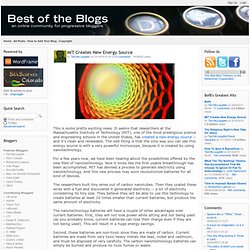
It seems that researchers at the Massachusetts Institute of Technology (MIT), one of the most prestigious science and engineering schools in the United States, has created a new energy source -- and it's clean and renewable. Sweden rolls out invisible infrared tank. High performance access to file storage Engineers in Sweden have announced the development of a prototype tank which is covered in "pixels" that enable it to disappear from thermal images – or to disguise itself as something else.

The "Adaptiv" system, funded by the Swedish Defence Materiel Administration (FMV), covers the test vehicle in hexagonal panels whose temperature can be quickly adjusted. The vehicle's own thermal cameras scan the background against which the tank is seen from each aspect, and the system can then adjust the pixels to match, making it very hard to see using thermal imaging systems. Molecular memory a game-changer. A team at Rice University has determined that a strip of graphite only 10 atoms thick can serve as the basic element in a new type of memory, making massive amounts of storage available for computers, handheld media players, cell phones and cameras.
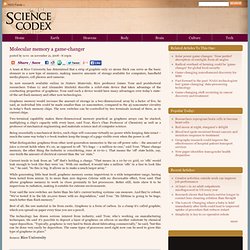
Motorola Droid Bionic Teardown. Video: New Atomic Clock Reaches A 100 Quadrillionth Of A Second Accuracy. A team of researchers at the University of Tokyo has developed a new type of optical atomic clock that boasts a 100 quadrillionth of a second accuracy (one quadrillion has 15 zeros).

The optical lattice clock is the brain child of Professor Katori who says his device observes a million atoms simultaneously whereas conventional atomic clocks measure time by using single atoms. The Professor explains: “(…) if one clock is placed one centimeter higher than another clock, the higher clock is affected by less gravity, so it goes faster. Building Computer Chips From Collapsing Nanopillars - News - Institute of Nanotechnology. The manufacture of nanoscale devices — the transistors in computer chips, the optics in communications chips, the mechanical systems in biosensors and in microfluidic and micromirror chips — still depends overwhelmingly on a technique known as photolithography.
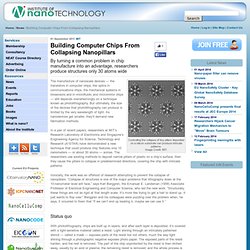
But ultimately, the size of the devices that photolithography can produce is limited by the very wavelength of light. As nanodevices get smaller, they’ll demand new fabrication methods. In a pair of recent papers, researchers at MIT’s Research Laboratory of Electronics and Singapore’s Engineering Agency for Science, Technology and Research (A*STAR) have demonstrated a new technique that could produce chip features only 10 nanometers — or about 30 atoms — across. World's Smallest Electric Motor - News - Institute of Nanotechnology. The smallest electrical motor on the planet, at least according to Guinness World Records, is 200 nanometers.
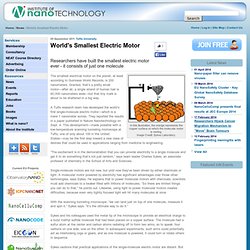
70 Things Every Computer Geek Should Know. The term ‘geek’, once used to label a circus freak, has morphed in meaning over the years. What was once an unusual profession transferred into a word indicating social awkwardness. As time has gone on, the word has yet again morphed to indicate a new type of individual: someone who is obsessive over one (or more) particular subjects, whether it be science, photography, electronics, computers, media, or any other field.
A geek is one who isn’t satisfied knowing only the surface facts, but instead has a visceral desire to learn everything possible about a particular subject. A techie geek is usually one who knows a little about everything, and is thus the person family and friends turn to whenever they have a question. Self replication. The best survey of self-replication written to date is Kinematic Self-Replicating Machines, a book co-authored by Robert A.

Freitas Jr. and Ralph C. Merkle, which describes all proposed and experimentally realized self-replicating systems that were publicly known as of 2004 ranging from nanoscale to macroscale systems, and presents for the first time a detailed 137-dimensional map of the entire kinematic replicator design space to assist future engineering efforts. A crucial objective of nanotechnology is to make products inexpensively. While the ability to make a few very small, very precise molecular machines very expensively would clearly be a major scientific achievement, it would not fundamentally change how we make most products. If we are to use positional assembly of molecular parts to efficiently build large structures (kilograms or more) then we will have to use some form of massive parallelism. Horses and cars both provide transportation. Complexity of self replicating systems. The Top 10 Supercomputers, Illustrated (June 2011) « Data Center Knowledge.
Like this story?
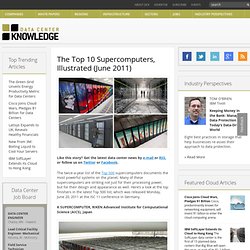
Get the latest data center news by e-mail or RSS, or follow us on Twitter or Facebook. The twice-a-year list of the Top 500 supercomputers documents the most powerful systems on the planet. Many of these supercomputers are striking not just for their processing power, but for their design and appearance as well. Here’s a look at the top finishers in the latest Top 500 list, which was released Monday, June 20, 2011 at the ISC 11 conference in Germany. K SUPERCOMPUTER, RIKEN Advanced Institute for Computational Science (AICS), Japan. RFID Implant in Hand Do It Yourself. EM4102 - 13mm Implantation - RFID Toys - Page 2.
CYNTAG. 9 Implants that make human healthy body even more useful. Here’s a list of 9 ways you can modify your body to be even more useful, from bionic implants to portable power generators.

AIDS is man-made - Interview with Dr. Boyd Graves. By FinalCall.com News | Last updated: Oct 5, 2004 - 11:42:00 PM What's your opinion on this article?

La5354ms.pdf. Google I/O 2011: Keynote Day One. Scientists: New Alloy Could Produce Hydrogen Fuel From Sunlight. The research, published in the Physical Review Journal, was funded by the U.S. Department of Energy and led by scientists at the UK Center for Computational Sciences and the University of Louisville Conn Center for Renewable Energy Research. The team demonstrated that an alloy formed by a two percent substitution of antimony in gallium nitride has electrical properties that enable solar light energy to split water molecules into hydrogen and oxygen through a process known as photoelectrochemical water splitting. The researchers found that when the alloy is submerged in water and exposed to sunlight, the chemical bond between the hydrogen and oxygen molecules break, allowing the hydrogen to be collected to separately. 10 Future Technologies That Already Exist. 22nm 3-D Tri-Gate Transistor Technology.
Using TI-Nspire™ Computer Link software to Disable Press-to-Test Mode. - Knowledge Base by Texas Instruments - US and Canada. How does the Computer Link software cause TI-Nspire family handhelds to exit Press-to-Test mode? Computer derives natural laws. Lindsay France/University Photography Professor Hod Lipson and graduate student Michael Schmidt adjust a double pendulum. Refectors on the pendulum enable motion-tracking software to record position and velocity as the pendulum swings.
From this a new computer algorithm can derive equations of motion. If Isaac Newton had had access to a supercomputer, he'd have had it watch apples fall and let it figure out what that meant. But the computer would have needed to run an algorithm developed by Cornell researchers that can derive natural laws from observed data. Airbus Concept Cabin – travel of future 2050 (video) It will have a see-through cabin to enjoy a picturesque view that will leave travelers enchanted.
The walls will alter in behavior as per the available light conditions. This will have power over air temperature, and when needed, will turn transparent. Neuroscience stories - io9.